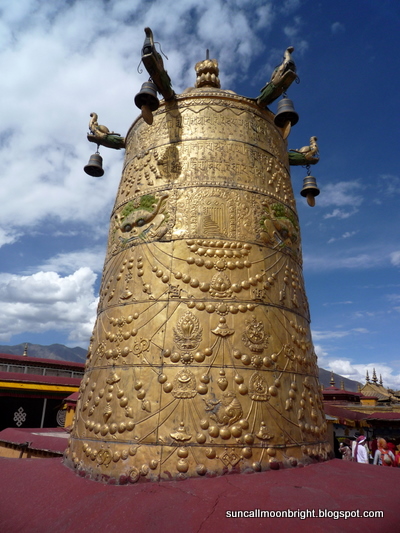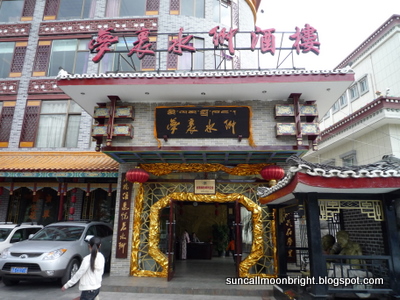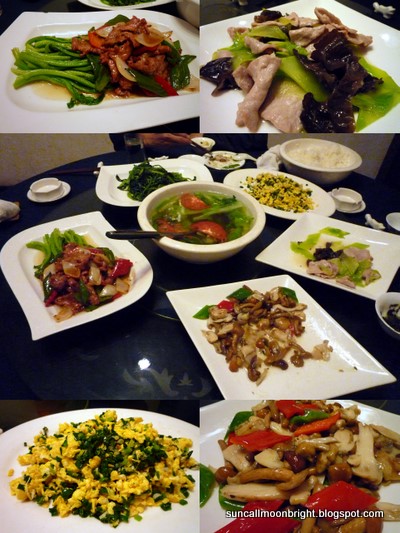View the previous related post here. Return to the trip index here.
04 Jun 2009
This morning, we visited one of the three great monasteries of the Yellow Hat Sect, the Drepung Monastery (哲蚌寺, Zhébàng Sì). The name loosely means, "snow white rice piling up high". It was founded in 1416 CE and was the most important monastery that housed the Dalai Lamas before the Potala Palace was built. Today it still remains as an import Yellow Hat Sect centre for learning and is somewhat a University, housing some 7700 lamas. This is also the trigger location of the worst unrest in Tibet the year before. That was probably the reason for the lack of tourists here compared to the other locations in Lhasa.
Drepung Monastery contains one of the largest thangka (Tibetan religious tapestry) of Buddha measuring some 35 by 30 metres. It is usually rolled up and kept in one of the monastery buildings but once every year, there is a "sunning of the Buddha" festival where the thangka is unfurled on a nearby slope. Devotees from far reaching places will come here to crawl under it to attain merits and everyone will be given local yoghurt.

At the bus park, rather empty for a tourist location. Interestingly, enroute to Drepung we passed some forest, a rare sight in Lhasa as most trees are destroyed by the punishing sun.

Obtaining tickets from the ticket office

Ticket showing Drepung's complex of buildings

"Om mani padme hum" Mani rock

Entering the monastery compound

Most of the monastery buildings are painted white with similar styled windows

Running water in the drain powers this water mani wheel, each spin recites "Om mani padme hum" once. This allows merits to be automatically accumulated although I am unsure who gets the merits.

More mani wheels

Being built on the slope of the hill, climbing steps and slopes is inevitable

The slope beside the monastery has the painting of Tsongkhapa, the founder of the yellow hat sect, on stone

On another nearby slope is the metal frame where the large Thangka of Buddha is placed to sun it during the festival. Colourful scriptures flutter in the wind.

Entrance to the Ganden Palace

This is the Ganden Palace and it is similar to the White Palace of the Potala. The top level is the abode for the Dalai Lama. It was constructed by the Second Dalai Lama and the other Dalai Lamas stayed here till the fifth constructed the Potala Palace and moved there.

Back outside, some of the main buildings that seem more important in red

The main building, two tall poles (left pole blocked) indicate that this is an important monastery and a place of learning. There was a police presence here and in other parts of the monastery as well. Taking pictures of them is strictly forbiddened. However they are accomodating of tourists and quietly moved out of sight so that we could take pictures of the buildings itself. Here, they have hidden behind the pile of wood on the left of the picture.
Being an important centre of learning, debating the scripture is also a common practice here. Although we did not get to see any while we were there. The rough procedure is one first claps his hand to throw questions at the other. Then, the debate will take place. Finally, the loser will wrap his beads around his head for laughs.
Being an important centre of learning, debating the scripture is also a common practice here. Although we did not get to see any while we were there. The rough procedure is one first claps his hand to throw questions at the other. Then, the debate will take place. Finally, the loser will wrap his beads around his head for laughs.

Follow your guide or you can quickly get lost among the various alleyways

Some living quarters

More alleys, we were descending, along the way we passed the monastery kitchen that houses one of the largest metal rice pots in Tibet. It must have been an enourmous undertaking to cook for the thousands of lamas here.

Another temple building

Murals outside

Dragon Murals on the ceiling

Descending further, the alleyways were spick and span albeit somewhat too quiet

Finally we were back below, a white scripture stupa stood near the bus park

Back on the bus, our coach captain was explaining how every bus in the company has this GPS device that allows the head office to track their positions 24/7!































